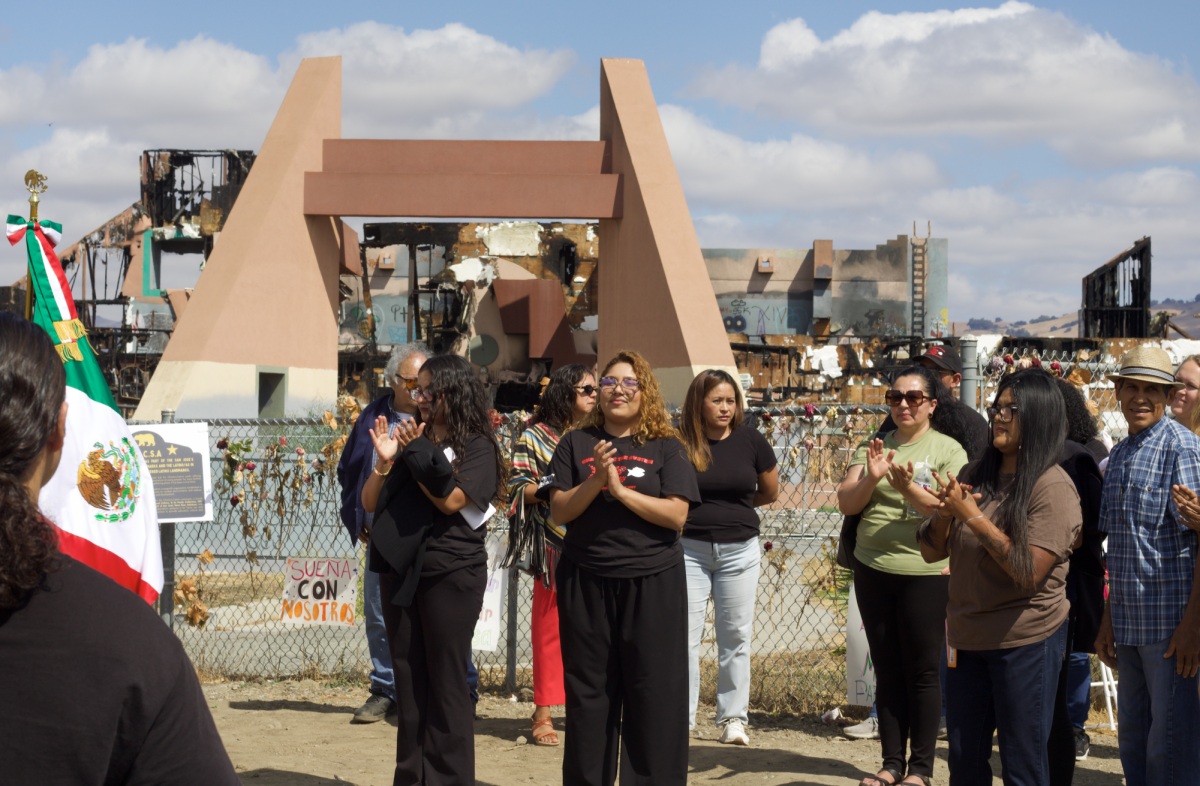
Lupita Ferreyra
Community activist groups gather in front of the Mexican American Community Services Agency (MACSA).
The vacant Mexican American Community Services Agency (MACSA) burned down early morning of Aug. 29 in East San José, following activist groups’ decade-long fight for it to be rebuilt.
MACSA provided “vital educational, recreational, vocational, cultural, and healthcare services to the surrounding Mayfair community,” according to the Preservation Action Council of San José.
The site is owned by the Alum Rock Union School District and was active from 1995 up until 2015, and has remained vacant since, according to the Latinos in Heritage Conservation website.
Non-profit organizations such as SOMOS Mayfair and the ¡Sí Se Puede! Collective has been advocating for the reopening of MACSA for years.
Olivia Navarro, SOMOS Mayfair community organizing director, shared her memories of visiting the site, as one of her children visited a couple of times as a participant.
“There were murals inside really rooted in community, culture, and really about the Mexican-American culture experiences here in San José,” Navarro said.
The resources provided by the center have been inactive since the site became vacant.
“It was built to be a beacon for the Mexican-American community and Latino community to receive services,” Navarro said. “Especially in an area where we know historically has been underrepresented.”
The San José Fire Department posted updates on X (formerly Twitter) about the fire that broke out in August.
“Firefighters responded to a 3-alarm structure fire at the abandoned MACSA Youth Center on the 600 block of Sinclair Dr,” according to an Aug. 29 X post by the SJFD.
Jake Pisani, SJFD public information officer, said further details cannot be announced, according to an email sent to the Spartan Daily on Sep. 8.
“The investigation by the SJFD arson unit is ongoing, and we’re unable to provide comment on an active investigation,” Pisani said in the email.
Whether the center can be rebuilt or not is dependent on the Alum Rock Union School District.
“I think that the school district would want to make it a priority to get it cleaned up since there might be hazardous material there,” Navarro said. “And depending on that and if we get the ground lease, then we’ll be able to go in.”
The Alum Rock Union School District’s Board of Trustees Resolution No. 12-25/26 proposed that demolition should be done inside the building.
The site requires removal and remediation to ensure safe conditions, according to the board resolution.
Navarro provides ways for the community to show support for SOMOS Mayfair and its advocacy to rebuild the youth center.
“You can register to continuously get information on what is happening in the project. When you go to our website, there’ll be a link if you want to make a contribution to the rebuild fund,” Navarro said.
Updates on MACSA can be found on the SOMOS Mayfair website, where there is also a section to donate.
However, Navarro explained that one of the most important ways to help is through being vocal with support.
“Not just following it, but if you can share it in your social media, make sure that we bring national attention to this, and it’s possible when we do go out and vote,” Navarro said.
On Sep. 11, there was national and local recognition for MACSA as it was officially named one of San José’s Endangered 8 Cultural Landmarks and an inclusion in Latino/as in Heritage Conservation’s list of 13 Endangered National Latinx Landmarks, according to a media advisory sent to the Spartan Daily.
“The building, it’s not about that – it’s about something much more, about what it meant to the community,” Navarro said. “And if we’re getting recognized nationally, that goes to show you that it’s beyond just the neighborhood.”
Ashley Guerrero, community organizer for SOMOS Mayfair, said her primary concern is how the loss of programs provided by organizations such as MACSA may impact the youth.
Guerrero spoke at the recognition event for MACSA, voicing why these efforts are so important.
“This isn’t just about a building, it’s about real, urgent needs: after-school programs, health education, legal support, and a place where young people feel seen, supported, and valued,” Guerrero said.
Gregorio Mora-Torres, a founding member of La Raza Historical Society of Santa Clara Valley and a Mexican-American Studies professor at SJSU, shared his concern for Mexican-American youth in San José.
“MACSA was created to meet the needs of the Mexican American community – first housing and poverty, later youth,” said Mora-Torres. “It has always been about survival and the future.”
The MACSA site is located in San José District 5, which is the district that councilmember Peter Ortiz represents.
Ortiz has been an advocate for the rebuilding of MACSA and spoke at the event about his personal connection to the youth center.
“This is personal for me. I myself attended programs here as a gang-impacted youth, and I will do everything in my power to make sure this plan follows through,” Ortiz said.
Earlier this year, Ortiz designated $500,000 to help save MACSA, but now it will be aimed towards rebuilding it after the fire, according to a Sept. 12 Instagram post.
Once all evaluations and investigations on site are complete, a full report on the fire will be shared by the board, according to the Alum Rock Union School District.
Navarro said the efforts to rebuild MACSA are not just about a building; it’s about history, culture, and community.
“MACSA has always been more than just a building. It has been the heart of East San José – a safe haven, a center for culture, education, athletics, and above all, a home for our community,” Navarro said.